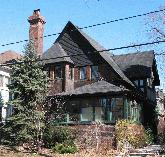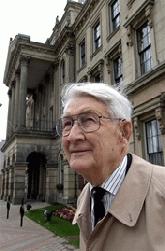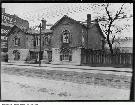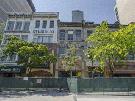1. Eden Smith's Own House for Sale
Bill Mohan, Real Estate Agent
 |
| Photo from TO Built |
I have the honour and privilege of offering for sale the Eden Smith family residence that he built in 1896 at 267 Indian Rd. It is being offered for $1,169,000. and will come to the market place on September 16th, 2013.
It is a very special home that has been featured in "Old Toronto Houses" 2003 by Tom Cruickshank and John DeVisser and is recognized as a historical property by The Toronto Historical Board, now Toronto Preservation Board.
Bill Mohan
Realtor- Sutton Group Realty Systems Inc. Brokerage 416-762-4200
2. Does Heritage Conservation Really Matter in "Ontario's most beautiful village"?
Ian Rankine
 |
| Street banners marketing Elora |
Group of Seven artist A.J. Casson fell "In Love with Elora" in the late 1920s and identified it as "Ontario's most beautiful village".
Today, cultural and natural heritage based tourism is the economic engine of Elora and it is marketed as �Ontario's most beautiful village�.
Since 1989, municipal Official Plans continue to designate the �Elora Heritage Area� and set out heritage conservation policy which wisely restricts development. This designation originated from the 1982 mapped inventory of century old built heritage resources, advice from the Wellington County and Township of Centre Wellington Planning Departments and the engagement of a large cross section of the community citizens in a visioning exercise.
In 2012, citizens of the Township of Centre Wellington ranked the protection of heritage resources as priority one in the "Culture Matters" study survey funded and undertaken by the municipality.
One would reasonably expect that the conservation of the designated �Elora Heritage Area� would be a top priority for the Township of Centre Wellington, but shockingly, that is not the case.
The municipality�s track record over the past decade with the �Elora Heritage Area� demonstrates a failure to consistently and effectively implement the provincial heritage conservation policy issued under the authority of the Planning Act which mandates that significant built heritage resources and significant cultural heritage landscapes shall be conserved.
Since the buildings and landscapes of �Ontario�s most beautiful village� immortalized by the artwork of A.J. Casson are all not surprisingly located within the designated �Elora Heritage Area�, its seems reasonable to expect that all of these heritage resources would be properly protected under the Ontario Heritage Act. Unfortunately, such is not the case. Only a few of the buildings painted by Casson in Elora are protected by designation under the Ontario Heritage Act, but most have outdated and ineffective designation by-laws. The municipality has even refused to �list� other Elora inventoried heritage buildings painted by Casson in the recent Municipal Heritage Register.
Municipal comments, submissions, advice, omissions and decisions appear to prefer growth through demolition, infill or intensification of the Official Plan designated �Elora Heritage Area� at the expense of the conservation of its cultural heritage landscapes and built heritage resources.
Township Mayor Joanne Ross-Zuj, County Warden Chris White and senior municipal staff appear to be unwilling to provide heritage conservation leadership and employ good heritage conservation planning tools (including, in part, heritage impact assessments, timely updating of property designation by-laws, heritage conservation district designation, heritage permits and a comprehensive and a complete municipal heritage register) in order to consistently and effectively conserve the heritage resources of the Township Official Plan designated �Elora Heritage Area�.
In summary, the conservation of the �Elora Heritage Area� does not appear to really matter to the municipal senior staff and elected leaders who continue to promote Elora as being �Ontario�s most beautiful village�.
Editor's Note:
This is an alarming story, Elora is one of the most beautiful spots in Ontario
3. Remembering Peter John Stokes
Catherine Nasmith
 |
| P. J. Stokes in front of Victoria Hall in Cobourg |
Representing Heritage Canada and the Architectural Conservancy of Ontario, I, along with many other heritage enthusiasts and friends, attended last week’s memorial service at St. Mark’s Anglican Church in Niagara on the Lake.
This was the first such service I can remember without family to lead it. Out of respect for his enormous contributions to the field of heritage preservation in Canada. colleagues and friends organized the celebration of his life.
Peter John Stokes devoted his career to the restoration of Canada’s early buildings as Canada’s first “consulting restoration architect”, working up to two weeks before his death of cancer. He and his wife Ann were immigrants to Canada from Britain (now infirm and without descendents), who left their quiet mark all over the country.
People came from many places to remember him. Remembrances came from friends, Bert Cunningham and Stephen Homer. Michael Howe of the Niagara Foundation talked about his work in Niagara-on-the-Lake. Friendships were formed during restoration projects, such as Upper Canada Village where Peter cut his Canadian teeth.
His last client, Susan Mitchell, described working with Peter Stokes for six years on restoring her house, a project that resulted in a deep friendship. Several friends told of how shared work had led to Stokes becoming a regular visitor, friend-sometimes akin to a godparent to many children. He seemed to be welcome on more than one sofa. One person told of Stokes’ transporting bricks from Ontario to New Brunswick in his car…..noting that Ann, his wife, took such shenanigans with a sense of humour. She was described as a string to Peter’s kite, providing anchorage.
Two noted his habit of always carrying a tape measure and a crowbar for investigations. He was never happier than digging around in derelict buildings, looking for clues to their stories. In his remarks, Julian Smith related Peter Stokes to the ideas of authenticity and integrity, principles that were ingrained in Stokes’ character and in his work. Smith talked of Stokes’ modesty and yet overwhelming impact on the field. For example, Natalie Bull, the Executive Director of Heritage Canada Foundation noted that it was his work in New Brunswick that first inspired her to pursue heritage conservation as a profession.
Last weekend, Phillip Pacey, of the Nova Scotia Heritage Trust noted that it was one of Peter Stokes’ sketches of a balcony railing, done during a National Historic Site designation visit, that was instrumental in preventing a modification for “safety” reasons by an overzealous congregation. I am sure there are many such stories out there among BHN readers. Without family, it will be us who will keep his memory.
The sculptor Jacobine Jones sponsored Peter Stokes to come to Canada. Her ashes were found in his estate and have been buried next to Peter J. Stokes in an unmarked spot under a large crab apple tree about 7 feet to the left of a headstone designed by Mr. Stokes, in the churchyard at St. Mark's. When Ann Stokes passes her ashes will go there as well. The oldest church in Ontario, it includes graves from the war of 1812.
Several in attendance, me included, felt the need for a marker, but perhaps that might not be his way or wish. His papers have been donated to Queen’s University. A small, ad hoc committee of Julian Smith, Chris Borgal, Stephen Otto and myself are considering how best to remember Peter John Stokes, wife Ann, and Ms. Jones.
If you have any thoughts, suggestions or remembrances, please contact one of us. We are interested in contacting the executor of the Stokes’ estate, but are uncertain how to do that. BHN would be happy to publish remembrances as a regular column in BHN until we have a chance to consider where else they might go. His estate asked for donations in his memory to go to The St. Mark’s Historic Properties Foundation, c/o St. Mark’s Anglican Church, 41 Byron Street, Niagara-on-the-Lake,Ontario, L0S 1J0
4. SMU Should Keep Icon of Women
Nova Scotia Heritage Trust
Saint Mary�s University should not demolish a building important to women�s history, according to several community groups represented at a press conference at 10 a.m., Tuesday, Sept. 17. The University has hired a contractor to demolish the Halifax Infants� Home, at the corner of Tower Road and Inglis Street; interior work is believed to have begun.
�The Halifax Infants� Home is a rare and important monument in women�s history,� said Linda Forbes, President of the Heritage Trust of Nova Scotia. �The building represents Victorian women helping women. Women raised the money to build this attractive building in 1899 and 1900.�
Sandra MacLennan, president of the Halifax Local Council of Women, noted that �Our first president, Emma Mackintosh, was very instrumental in building the Halifax Infants� Home.� The press conference was held in the Council�s premises at 989 Young Avenue.
Dr. Judith Fingard, author and historian, said the building should be preserved �to provide a reminder of the era of institutionalization, a defining feature of our past�, �to commemorate women who volunteered their help to promote the welfare of women and their infants�, and �to recognize that girls and young women who came to such maternity homes were often victims of violence or coercion�.
Stella Lord, advocate of social justice and women�s rights, and adjunct professor of Sociology and Women�s Studies at Saint Mary�s, asked the university to transform the building into �a place to enable students, faculty and the broader community to foster gender equality, social justice and civic engagement on campus and abroad.�
�The University has an opportunity to continue to own an important masterwork by J.C.P. Dumaresq, the leading Victorian architect in the Maritimes,� said Elizabeth Pacey, author and architectural historian.
Staci Simpson of the Saint Mary�s Women�s Centre said �We should protect, not destroy, the Halifax Infants� Home.� The Centre, the Trust, the Council and the Canadian Federation of University Women are all supporting the retention of this building.
Daren Miller of Calgary, a Saint Mary�s University alumnus, also spoke in favour of retaining the building and against rape culture. The group then walked to the Infants� Home at the corner of Tower Road and Inglis Streets, where Mr. Miller returned his degrees to the University.
Contact:
Linda Forbes, 469 3695, 476 0482; Elizabeth Pacey, 422 8814, 237 2927; Judith Fingard, 422 5052; Stella Lord, 477 0094.
- 30 -
5. Toronto Star: St. Mary's Chant Reaction Assists in Saving former Halifax Infants Home
Melanie Patten
Saint Mary�s University grad returns degrees in anger over sexist chant
 |
| Halifax Infants Home, from Heritage Trust of Nova Scotia webpages |
HALIFAX—A former student at Saint Mary’s University in Halifax returned two degrees Tuesday that he earned 18 years ago at the school, saying he’s disgusted by a chant sung at frosh week that glorified the sexual assault of underage girls.
Trailed by a group of reporters, Daren Miller of Calgary walked to the school’s campus carrying his bachelor’s degrees in arts and commerce where he was met by the university’s registrar, Paul Dixon.
The two exchanged few words before Dixon took the scrolls and walked away.
“To me, those degrees are valueless,” said Miller, 42. “I wanted to distance myself (from) the embarrassment and shame I felt from this sort of culture.
“I am not that kind of guy.”
Editor's Note:
The Nova Scotia Heritage Trust joined in this protest, as a way of arguing for preservation of the threatened, St. Mary's University owned, former Halifax Infants Home, a retreat for unwed mothers--making important alliances for preservation. I understand the immediate threat to the building is over.
Click here for Link
6. Torontoist: Moving into Regent's Park
Jamie Bradburn
Historicist: Moving Into Regent Park
When the first phase of Regent Park opened in 1949, everyone was transfixed by the bathtubs.
During the initial viewings of the first completed units of the Regent Park housing project in March 1949, incoming residents and the press were transfixed by a household fixture most Torontonians took for granted: the bathtub. As the Telegram observed, “If you haven’t had one in your home for eight years; if you have had to bathe five growing children in an old washtub, or sponge-bath them by the kitchen sink because you live in a condemned house without a tub or any hot water except what you heat on two old-fashioned stoves, then a shiny-new tile bathtub in a clean seven-room house really means something.”
The presence of a bathtub in their future home convinced railway worker Alfred Bluett and his wife that their family would finally escape their condemned home across the street at 218 Sumach Street. “We have always been in the dumps, all our lives,” he told the Telegram. “We are going to start life anew over there.” When she saw the bathtub, Mrs. Bluett was ecstatic. “I’m going to sit in it for a year. Just let anyone try and get me out.”
Click here for Link
7. Toronto Star: 24 Mercer-One of Toronto's Oldest Buildings
Betsy Powell
Downtown Mercer St. heritage building at centre of tug-of-war over its future
Its owner and award-winning filmmaker tenant love the red-brick building at 24 Mercer St., yet want it torn down and redeveloped into a boutique condo building.
And there appears to be no community opposition despite the building’s designation as a heritage property.
Nevertheless, staff in Toronto’s planning division are recommending that city council refuse the proposed teardown. The issue comes to Toronto and East York community council Tuesday.
“It’s a special building,” says Ron Mann, on a smoke break outside the building where he’s rented space since 1985 and is currently editing his next documentary.
Over the decades, he’s watched the transformation of the entertainment district and Mercer St. He intends to purchase two floors in the proposed live/work space, one to live in, the other for business.
“They’re going to bury me on Mercer,” he joked.
Editor's Note: More photos and a detailed history available at the link below.
http://tayloronhistory.com/2013/07/18/torontos-architectural-gems24-mercer-street/
Click here for Link
8. Toronto Star: Five Condo's Yonge and St. Joseph
Ryan Starr
Heritage elements a market stand-out at Five Condos
Heritage architect Michael McClelland believes Five Condos at 5 St. Joseph will set a new standard for future development along Yonge St.
The condo project incorporates a stretch of 19th-century buildings on Yonge, and the 1905 Gothic revival brick facade of an old warehouse on St. Joseph St.
Set farther back on the site will be a new, 48-storey glass condo tower.
“I think we’ll see the community, the city and the heritage department looking to Five as a template for what should occur along the remaining undeveloped or redeveloped parts of Yonge,” says McClelland, a principal with E.R.A. Architects, the group managing the heritage elements of the project.
Preserving historic architecture can be a costly and time-consuming endeavour, acknowledges Stephen Price, president and chief operating officer of Graywood Developments, the firm that’s building 5 St. Joseph in partnership with MOD Developments.
Editor's Note:
This project is definitely an improvement from saving just the facades. What would really be terrific is if the shops could be sold as condominiums to preserve the ability of a business to own, not rent its own premises. That will bring longevity and stability to the business strip, and more closely replicate the historic activity and ownership pattern of our retail strips.
Click here for Link
9. Toronto Star: Plant Ontario Wildflowers at Ontario Place
Joe Fiorito
Can we have more �Ontario� in Ontario Place?
Jim French wants an interpretive park, full of native trees and flowers, at Ontario Place.
Jim French has his summers worked out pretty well. He spends five days of the week at the cottage, and two days in town, playing bridge with his wife.
Hey, it works for both of them.
We were chatting the other day, not about his marital arrangements, but because he has another, even more brilliant idea.
Wait for it.
Jim is a retired insurance guy, observant, nearing 80 years of age. He has a gimlet eye and a straightforward outlook. For our purposes today, he is also an expert in the wildflowers of Ontario.
Editor's Note:
And wouldn't it be a good idea to offer other aspects of Ontario History at Ontario Place, goodness knows none is offered at the Royal ONTARIO Museum....which does a great job on other topics, but it seems amazing that there is nowhere to go to find out about Ontario....
Click here for Link
10. Toronto Star: Sam the Record Man Sign
Councillor Josh Matlow worries Sam the Record Man sign is damaged
 |
| Sheldon Levy in Front of Sam's Sign |
Rumours suggesting Sam the Record Man’s iconic sign has been “damaged beyond repair or even destroyed” have Councillor Josh Matlow so concerned, he’s written to Ryerson to ask to see the sign for himself.
“I would like to reassure residents that Ryerson University has gone to lengths to protect and preserve the sign that are commensurate with its civic importance,” he wrote in a letter to Ryerson president Sheldon Levy last Tuesday.
“I’m not suggesting that the rumours are true,” Matlow told the Star Wednesday after having received no response for more than a week. “The best way to quash them is to see (the sign) with my own two eyes.”
Ryerson denies the sign is damaged in any way and is “in the process of arranging the logistics for the councillor and city staff to visit and see the sign in storage.”
“The sign was carefully disassembled, each component labelled and then crated before being placed into storage,” wrote Ryerson spokesperson Michael Forbes in an email to the Star.
Click here for Link
11. Spacing Blog: Sam the Record Man Sign/What is Heritage Anyway?
John Lorinc
LORINC: The Wychwood Barns, Sam�s sign, and how we know what heritage means
Not long after I moved into the St. Clair West area, in the mid-1990s, I heard about a City-run consultation on the future of the long shuttered TTC car barns property between Wychwood Avenue and Christie.
The meetings took place in a stuffy former classroom in the Hillcrest Community Centre, facilitated by a droning planner. He turned up to each session armed with various plans that included features ranging from a senior’s home (fronting Christie) to a suburban-style subdivision, complete with cul-de-sac. Some participants (myself included) decided to play urban planner and submitted home-made schematics. It all seemed rather open-ended and opaque.
Throughout, the underlying assumption was that those dusty old buildings, hidden largely from view by perimeter hoardings, would be razed to make way for something new, although what that something would be remained unspecified.
At one point, a couple of people from a tiny group called Stop 103 began to attend, and they tentatively raised the notion of repurposing those buildings for arts, environmental and social organizations. The idea struck me as a long-shot — that is, until 1998, when the local councillor, Joe Mihevc, persuaded the TTC to allow visitors to peer into the barns and witness their tattered majesty up close.
Click here for Link
12. Urban Toronto: At last Corktown Cottage Rehab
Jack Landau
Derelict Corktown Heritage Cottages Get Much-Needed Refresh
If there is one word guaranteed to rile up the tempers of both architecture and heritage enthusiasts, it would have to be façadism. Preserving only the outer shell of a building is often written off by critics as lip-service; a clumsy homage meant to appease the public with the bare minimum of effort. That feeling has been compounded as much façadism in Toronto has occurred when the old building has otherwise been bulldozed to make way for a new tower, and the resulting heritage skin graft onto a new skeleton rarely serves to enhance the new building or sensitively memorialize the old one.
The restoration of the façades of the Little Trinity Church Workman’s Cottages at 399 King Street East is a bit of a different case. Here the front façades have returned, looking just as they did when built, with no new looming high-rise behind. Saving more than the façades was another matter, however.
Click here for Link
13. Globe and Mail: Modernism: Knoll to the rescue to prevent modernist losses
Dave LeBlanc
An era�s buildings face the wrecking ball
 |
| Take a last look at one of Howard Chapman's finest buildings |
Despite the cheerleading you’ve become accustomed to seeing in this column – I like to think of “The Architourist” as the Elwy Yost of Modernist architecture – we continue to sit at a crossroads. Choices we make in the next few years about who runs our city, how much power the Ontario Municipal Board can wield, how we use the amendments to the Ontario Heritage Act, which buildings we rally to save, and which we ignore, will tell our grandchildren much about who we were.
The Modernist buildings built between 1945 and 1975 are now at the same point in their lifespan as the Victorian and Edwardian buildings they replaced, which means their owners are, right now, deciding their fate. The former Riverdale hospital at Gerrard Street East and Broadview Avenue, known to many as the “half-round,” is coming down; the loss of Peter Dickinson’s Inn on the Park and John C. Parkin’s Bata Shoe headquarters still stings for some.
Every day, owners of small office or apartment buildings decide to “remuddle” by changing details that seem insignificant – a light fixture, an open-concept plan, a tiled wall – but, in so doing, destroy the very things that make their properties Modern (remember, Modernism is light on ornament, so removal/replacement of anything, no matter how small, can make a huge impact). Some postwar neighbourhoods are entering their third decade of McMansionization; soon, many won’t have enough originality left to bother pursuing a Heritage Conservation District designation.
Over the past few years, however, there have been encouraging signs. As reported in this space in 2010, new owners of the 1957 Imperial Oil headquarters at 111 St. Clair Ave. W., Camrost-Felcorp, successfully marketed their new condo as “mid-century modern” without frightening off well-heeled Forest Hill buyers; earlier this year in Ottawa, Canada’s very first Modernist HCD was created in Briarcliffe (also reported here).
Editor's Note:
The subject of the imminent demolition of the former Riverdale Hospital is a trigger for this article. It was one of the worst losses in recent Toronto memory, truly significant and unnecessary. I am thrilled that Knoll is getting into the ring....perhaps 10 years to late for several of Toronto's most important modernist losses, but welcome nonetheless
Click here for Link
14. Globe and Mail: An era�s buildings face the wrecking ball
DAVE LEBLANC
 |
| Riverdale Hospital demolition, 2013. (Dave LeBlanc For The Globe and Mail) |
Despite the cheerleading you’ve become accustomed to seeing in this column – I like to think of “The Architourist” as the Elwy Yost of Modernist architecture – we continue to sit at a crossroads. Choices we make in the next few years about who runs our city, how much power the Ontario Municipal Board can wield, how we use the amendments to the Ontario Heritage Act, which buildings we rally to save, and which we ignore, will tell our grandchildren much about who we were.
The Modernist buildings built between 1945 and 1975 are now at the same point in their lifespan as the Victorian and Edwardian buildings they replaced, which means their owners are, right now, deciding their fate. The former Riverdale hospital at Gerrard Street East and Broadview Avenue, known to many as the “half-round,” is coming down; the loss of Peter Dickinson’s Inn on the Park and John C. Parkin’s Bata Shoe headquarters still stings for some.
Every day, owners of small office or apartment buildings decide to “remuddle” by changing details that seem insignificant – a light fixture, an open-concept plan, a tiled wall – but, in so doing, destroy the very things that make their properties Modern (remember, Modernism is light on ornament, so removal/replacement of anything, no matter how small, can make a huge impact). Some postwar neighbourhoods are entering their third decade of McMansionization; soon, many won’t have enough originality left to bother pursuing a Heritage Conservation District designation.
Over the past few years, however, there have been encouraging signs. As reported in this space in 2010, new owners of the 1957 Imperial Oil headquarters at 111 St. Clair Ave. W., Camrost-Felcorp, successfully marketed their new condo as “mid-century modern” without frightening off well-heeled Forest Hill buyers; earlier this year in Ottawa, Canada’s very first Modernist HCD was created in Briarcliffe (also reported here).
Groups such as the Toronto Society of Architects, Heritage Toronto, the Architectural Conservancy of Ontario, the Ontario Association of Architects and Parks Canada have all advocated for the preservation of Modernism. The problem, however, is that these groups often have dreams much bigger than their budgets.
What this fight needs, then, is a major global player with deep pockets.
In 2006, Modern furniture pioneer Knoll teamed up with the World Monuments Fund for the “Modernism at Risk” initiative. Pledging to take a “more active role” in “advocacy, conservation, and public education,” this power-duo has produced real results. When a 1954 public library by Marcel Breuer in Grosse Point, Mich., was threatened with demolition and replacement in the mid-2000s, a group of young designers alerted the WMF, who placed it on a watch list. Eventually, the Modernism at Risk program helped fund research and studies that convinced library trustees to expand and reuse Breuer’s building.
Click here for Link
15. Blog TO: Globe & Mail development reveals lost Toronto mansion
posted by Chris Bateman
 |
| photo taken just before 1925 demolition of Berkeley House |
Workers surveying the ground for what will become the new King Street East offices of the Globe and Mail unearthed brick foundations and a handful of tantalizing artifacts from a long lost Toronto house last week.
Unlike cities with a longer history of occupation, new construction in Toronto seldom turns up a rich archaeological site, so when glass containers, pieces of crockery, and even an unbroken lightbulb emerged from the muck, it felt special.
The mansion was once home to the victor in a famous and deadly duel, before falling in to dereliction and ultimately being knocked down in the 1920s, overshadowed by chimneys and smoke in the industrial east end.
Click here for Link
16. Globe and Mail: Kingston Penitentiary Closing
Stevie Cameron
Kingston Penitentiary: Canada�s most famous prison closes its doors
Last week, a retired prison guard volunteering at the Penitentiary Museum across the road from the Kingston Penitentiary, looked out the window at his old workplace. “Today they’re moving the patients out of the hospital,” he muttered … to no one at all. He seemed sad. The hospital had cared for approximately 130 mentally ill prisoners on the penitentiary site, and now was sending their patients to units at nearby Millhaven, a maximum-security prison, and to Bath, a medium-security prison.
Many other people in Kingston are sad to see the penitentiary close. They understand it’s old – after all, the first building opened in 1835 – but they love it. So many of them have worked there or volunteered there. It’s been a lab and training school for students from Queen’s University in law, psychology, medicine, and education. Professors often held classes in the penitentiary for inmates; one was the distinguished artist André Biéler who ran a course he called “Escape Through Art.”
Click here for Link
17. Hamilton Spectator: Developer wants to tear down back of �crumbling� James Street Baptist Church
Matthew Van Dongen
 |
| The 135-year-old James Street Baptist Church is in danger of partial collapse, according to information provided to the city. |
Call it the last salvation tour at James Street Baptist Church.
Two weeks from now, hard hat-wearing heritage guardians will eyeball the crumbling walls and bulging support pillars of the 135-year-old downtown church before meeting to consider a partial demolition application.
"Bits of it are already falling down. We're told there is a real danger of partial collapse," said Michael Adkins, co-chair of the city's heritage permit review subcommittee. "They think one more winter of freeze-thaw could have calamitous results."
Toronto developer Louie Santaguida bought the historic-but-crumbling building early this year with plans to explore potentially "dramatic" redevelopment — think multi-use residential, commercial space or even a boutique hotel. At the time, it was estimated the church needed $2 million in repairs.
But Wednesday, the subcommittee learned the developer feels he can preserve only the front-third of the building, including the iconic stone entrance and tower. Engineering reports deem the rest of the 1880s-era sanctuary unsalvageable, painting a picture of crumbling walls, water damage, bowing support pillars and unstable foundations.
"It does appear to be in bad shape, but I want more information before making a recommendation," said Adkins, who will tour the church with other committee members Oct. 9, before considering the demolition permit application. "This will likely be one of the most important downtown heritage decisions we make in some time."
The Spectator was unable to reach Santaguida Thursday.
But McCallum Sather architect Drew Hauser said the design team is committed to protecting as much of "tremendous heritage asset" as possible, adding he was troubled by the skepticism of some committee members Wednesday.
Click here for Link
18. Hamilton Spectator: Gore Steetwall
Matthew Van Dongen
City dangles cash carrot before Gore developer
The city is about to sweeten two grant programs that will make up to $1 million available to a Gore developer if he preserves and designates five historic buildings slated for demolition.
The cash carrot likely isn't enough to save the "falling down" structures between 18 to 28 King St. E, said developer David Blanchard Tuesday.
But he didn't rule out applying for some of the newly available grant money to help preserve façade elements — a tentative plan worked out with city councillors and staff as bulldozers threatened the buildings this summer.
"We're trying to be accommodating, but those building were falling down when we bought them and that hasn't changed," he said. "I don't see the (sweetened grant program) changing the conversation."
Click here for Link
19. Raise the Hammer: Surprise Demolition Permit Request for James Street Baptist Church
Joey Coleman
The City's Heritage Permit Review Committee has tabled a report requesting a demolition permit for most of James Street Baptist Church.
 |
| RTH - Only the shaded area will be retained |
he City's Heritage Permit Review Committee has tabled a report requesting a demolition permit for most of James Street Baptist Church. According to the 129-page report, which the committee only received at the start of the September 25 meeting, the building is structurally unsound and should be demolished before winter to protect public safety.
The developer provided the 129-page report to staff in advance of the meeting.
The sudden appearance of this report just before the meeting is highly irregular. It was not included with the agenda, which was made available late on Tuesday afternoon. Further, documents in addition to the report were shared with committee members but have not yet been made available to the public. Worse still, the committee meeting was scheduled at the same time as this week's City Council meeting.
(Note: I was in attendance at the Committee meeting while a volunteer operated the camera to livestream Council.)
A hearing for as important an issue as the proposed demolition of James Street Baptist Church should not take place at the same time as Council, and copies of the report should have been made available to committee members and the public with enough advance notice to read it.
Click here for Link
20. Opportunity to Share Ideas about Heritage With Kathleen Wynne
Catherine Nasmith
Common Ground
Here's your chance to suggest things that would better protect Ontario's cultural heritage.
Such as:
- Involving communities in decisions regarding green energy, and taking seriously the need to protect cultural heritage in that process. ie. and SAVE THE BALA FALLS
- Having the Minister of Culture and the Ministry better recognize the importance of Ontario's historic places to our quality of life, and to economic development, and tourism, his other portfolio. That might mean becoming assertive with municipalities and other ministries when cultural heritage is threatened.
- Making sure there are better post secondary education opportunities in heritage conservation, architecture, planning, and craft.
- Heritage conservation employs twice as much labour as conventional construction, uses significantly less material....that is good for environment.
- Discourage suburban sprawal
- Assisting communities with regenerating Main Streets
- Encouraging economic innovation by preserving the places that new ideas thrive, Ontario's older buildings.
- Conserving Ontario's environment by reducing building waste...Landmarks not Landfill
- Re-instating Ontario Northland, Ontario's historic rail system
- Encouraging rail transport into the historic town centres
- Teach Ontario history, its hard to value what is not understood.
You have your own ideas too no doubt.
Click here for Link
21. OTTAWA CITIZEN: Most of controversial Lowertown schoolhouse can�t be saved, city agrees
David Reevely
 |
| Rod MacIvor , The Ottawa Citizen - 287 Cumberland St. to be demolished, as long as the owner carefully documents the building first and preserves the south and west walls of the schoolhouse |
TTAWA — Most of the notorious Lowertown schoolhouse that has pitted the city against an obstinate landlord must be torn down, city experts say.
The former Our Lady schoolhouse dates from 1904. It and an adjacent row of houses have been deteriorating for years under the ownership of Claude Lauzon, a prominent Lowertown landowner who’s let it go while pursuing various half-hearted redevelopment plans. Last winter, the city declared it a public safety hazard and ordered him to fix it up. Lauzon brandished an engineer’s report saying nobody could safely enter it and argued it could only be demolished.
The two sides ended up in court.
There now seems to be a compromise. Next week, the city’s committee on historic buildings is to vote on a plan to allow most of the buildings to be demolished, as long as the owner carefully documents the building first and preserves the south and west walls of the schoolhouse. A report explaining the recommendation says two separate structural engineering examinations have conclude the rowhouses are beyond repair.
The buildings themselves aren’t formally designated as heritage structures, even though they’re old by Ottawa standards. But they’re in a “heritage district,” which means they can’t be torn down without the city’s permission because they’re part of the overall fabric of a historic area.
“Two experts in heritage engineering have examined the properties and concluded that because of the cumulative effects of years of neglect, this is the only option for the buildings,” says a report from the city’s planning department. “The department also supports the proposed application because a replacement building on the site will ensure that future development will respect the cultural heritage value of the heritage conservation district.”
Click here for Link
22. Wall Street Journal: Masonic Temples Reborn as Luxury Condos
Nancy Keates
A growing number of Masons are selling their aging temples to developers who convert them into luxury condos.
 |
| A global, fraternal organization that dates back to the 18th century has a wealth of historic meeting spaces under it's watch that are hitting the market. Photo: Andy Snow for WSJ |
When Larry Schier walks into the Masonic club on Manhattan's Upper West Side, there are no secret handshakes or symbolic rituals taking place. He is just coming home.
Mr. Schier, an agent with the Corcoran Group in New York, lives in a 2,800-square-foot condo in the former Masonic club and hotel called the Level Club on West 73rd Street. Attracted to the 14-foot ceilings and arched windows, he bought his first apartment there in 1984 for $287,000 and combined it with an apartment he bought next door in 2000 for $610,000. Since then, Mr. Schier has sold more than 130 apartments in the building, including a three-bedroom, two-bath unit listed for $2.7 million and under contract. He plays up the history of the building and the features associated with the Freemasons: the "exquisite stone-carved symbols" and its "exclusive allure of an ultra-prestigious club."
Freemasonry—a global, fraternal organization that dates to the 18th century with a goal of "Making Good Men Better"—was once a major force in American society. Members included George Washington, Ben Franklin and Andrew Mellon. Between the late 1870s and the early 1930s, members built large and elaborate temples and lodges across the country, often with imposing facades and intricate carvings.
Today, with membership down to about a million from four million in the 1950s, the Masons can't afford the upkeep of all these antiquated buildings, which are typically in downtown areas with limited parking. The absence of working elevators also makes the buildings difficult for aging members to use.
Click here for Link
23. Spacing: Toronto City Hall as Star Trek star
Adam Brunch
Star Trek and Toronto City Hall
Toronto has made an appearance in the Star Trek universe twice and both times it’s been thanks to Nathan Phillips Square. When our new City Hall first opened in 1965, Viljo Revell‘s design was, famously, on the cutting edge of modernism. The curved concrete and clam dome were the stuff of the future. Even now, they have something of an otherworldly feeling.
The first time Toronto showed up in a story about the crew of the Enterprise was in 1969. It wasn’t on television, though: it was in a silly Star Trek comic book called “The Ghost Planet“. Kirk and Spock beam down to a world surrounded by rainbow rings, only to discover that it’s been ravaged by war. The city they beam into lies in ruins, but there’s Toronto City Hall, still standing. Nathan Phillips Square was the inspiration for the artwork. Kirk and Spock eventually discover the warlords responsible for the carnage (identical twins both named Justin) who trick the crew of the Enterprise into disabling the rainbow rings (which somehow force the Justins to be peaceful) so they can resume their war against each other. Eventually, the good guys realize what’s happening and McCoy projects film of the rings into the planet’s atmosphere to trick the Justins into putting down their weapons.
Click here for Link
24. thechronicleherald.ca: Heritage group cool on Commerce Square proposal
SHERRI BORDEN COLLEY
 |
| The development, called 22nd Commerce Square, will span the area bounded by Granville, George, Hollis and Duke streets |
The Heritage Trust of Nova Scotia is pleased to see that the company planning a 500,000-square- foot, twin-tower development in downtown Halifax is proposing to keep the former Bank of Commerce Building on George Street.
However, the trust is disappointed that Robin Halifax Holdings Ltd. is not proposing to keep the other four buildings on the block, except as facades.
“Heritage buildings are three-dimensional objects, and it is important to keep all three dimensions to truly be able to appreciate their architecture and their history,” Phil Pacey, chairman of the HRM committee of the Heritage Trust of Nova Scotia, said Wednesday.
The development, called 22nd Commerce Square, will span the area bounded by Granville, George, Hollis and Duke streets.
It will include a 96-suite boutique hotel, a public atrium, a restaurant and conference centre in a restored Bank of Commerce building, and 88 condominium units.
It will also have 200,000 square feet of office space, street-level retail space along Granville, Duke and Hollis streets and underground parking for 300 vehicles.
The family-owned company owns Royal Bank Tower and the block on which it stands, and also the BMO and TD buildings in downtown Halifax.
In addition to the former Bank of Commerce, the block includes four buildings registered under the Municipal Registry of Heritage Properties: the Hayes Insurance, Merchants Bank of Canada, Champlain and Flinn buildings.
The entire block will be vacated and the Royal Bank building and some others will be demolished.
Click here for Link
25. Palladium-Item (Indiana):Historic buildings could get new lease on life
Pam Tharp
Proposed $10M project would turn upper floors into 55 loft-style apartments
 |
| The Knollenberg building on East Main Street in Richmond is one of three in a proposed renovation project. / Joshua Smith / Palladium-Item |
The Richmond Redevelopment Commission got its first look Wednesday at a proposed downtown housing project that would upgrade three historic retail buildings.
Peter Schwiegeraht of the Miller-Valentine Group of Cincinnati presented plans for the $10 million project at the commission’s monthly meeting. Developers are hoping to obtain some level of city support for the project to strengthen their application for tax credits from the Indiana Housing Community Development Authority, said Tony Foster, Richmond’s director of metropolitan development.
Plans call for renovating the upper floors of the Odd Fellows building, the Knollenberg building and the Hittle building, which is located on the northwest corner of Ninth and East Main streets.
The remodeling would preserve all first-floor commercial space, according to the application filed with the redevelopment commission.
The development would include 55 loft-style apartments among the three buildings, a mix of one- and two-bedroom units, Schwiegeraht said. The work would be consistent with Richmond’s Stellar Community plans, he said.
Richmond was designated a Stellar Community by the state of Indiana earlier this year, making it eligible for funding for a series of projects that includes enhancing East Main Street buildings between Fifth and 10th streets by renovating storefronts and creating housing on upper floors.
Click here for Link
26. New York Times: Evelyn Ortner, 82, a Booster of Brooklyn Brownstones, Dies
ANEMONA HARTOCOLLIS
 |
| brownstoner.com - 272 Berkeley Place |
Evelyn Ortner, who with her husband, Everett, was among the first, the most vocal and the most effective champions of the brownstone revival that spread from Brooklyn to the rest of the country, died on Tuesday at her home in Park Slope. She was 82.
The cause has not been determined. She had a mastectomy two weeks ago, but had seemed to be doing well until her death, her husband said.
Victorian homes had fallen into disfavor and many middle-class New Yorkers were moving to the suburbs by 1963, when Mrs. Ortner and her husband bought a four-story 1886 brownstone on Berkeley Place in Park Slope.
Mrs. Ortner, an interior designer before she became a preservationist, was so enchanted by that house, with its original mahogany woodwork and papier-mâché and linseed-oil wallpaper, that she began a campaign to save thousands of other brownstones from neglect or the wrecking ball.
Click here for Link
27. Arch Record: Adaptive Reuse of Buffalo State Asylum for luxury hotel
C. J. Hughes
Fixture of Buffalo Skyline To Be Revived
A rendering of the new glass atrium that will mark the entrance to the hospital-turned-hotel.
In Buffalo, a hospital by some of the best-known designers of the 19th century, left for dead in the 20th, is being revived as a boutique hotel. The landmarked Buffalo State Asylum for the Insane, by Henry Hobson Richardson along with Frederick Law Olmsted and Calvert Vaux, is adding an 88-room hotel and conference center, as well as fresh landscaping, as the Rust Belt city bets that its architectural heritage can attract tourists.
The redesign, led by Deborah Berke Partners and finalized last month, will also relocate the hospital’s main entrance to a new atrium, whose glass walls will provide a modern contrast with the building’s dark sandstone exterior. “We wanted to do something clearly of this time, not some fake-it-old version,” Berke says. “It will also be transparent, to highlight Richardson’s work.”
Expected to break ground early next year, the hotel, which will cost $56 million, is part of a multi-phase, $81 million project, which is mostly being paid for with state funds allocated last decade. But private investors, spurred by tax credits, are expected to contribute $19 million. The hotel’s lobby will be located inside the hospital’s main building, whose twin towers, and their screwdriver-head-shaped green tops, are fixtures of Buffalo’s skyline. Berke’s design team, which includes Goody Clancy and local practice Flynn Battaglia Architects, will also create meeting rooms, a restaurant, and a ballroom inside the five-level space.
Editor's Note:
Wow, A great vote of confidence for Buffalo
Click here for Link
28. Herald Scotland: Death of Charles McKean, Architectural Historian
Neil Baxter
Charles McKean Architectural historian
Born: July 16, 1946; Died: September 29, 2013.
Professor Charles McKean, who has died aged 67, was a distinguished architectural historian, commentator and prolific author. One of the most influential Scottish historians of his era, he is also credited with revitalising the Royal Incorporation of Architects in Scotland and giving the organisation real relevance.
Prof McKean was an extraordinary enthusiast, an engaging companion and an architectural historian who was never afraid to challenge the received wisdom in his field. He also fundamentally influenced the lives of all those who worked alongside him and studied under him and can take credit for transforming Scotland's attitude to and understanding of, our nation's architecture.
Prof McKean's service to Scotland, to the understanding of its built heritage and to engaging the public in the care and sharing of that heritage has been equalled by very few. He was a distinguished scholar and a polymathic adventurer in the realms of antiquity. He was an enthusiast whose legacy is a huge number of erudite and engaging publications and the transformation of architectural practice in Scotland and world understanding of our unique and precious architectural heritage.
Click here for Link

































